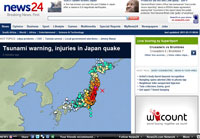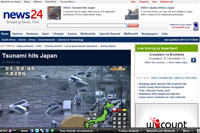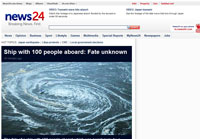Trending
Elections 2024
Jobs
- Media Director Cape Town
- Junior Digital Business Writer Roodepoort
- WordPress Website Designer/Graphic Designer Johannesburg
- Online Sub Editor Johannesburg
- Telesales Representative Durban
- Social Media Manager Cape Town
Breaking news. One way or another.

Like so many stories these days, we first got wind of the Japan earthquake at News24 via Twitter. Those of us with an eye on Twitter in those first few moments passed on the info to the necessary editorial staff on our day- and multimedia teams, and went about our jobs. (There are often updates on the wires about quakes each week, so we operate as per normal on the editorial desk until we get more information in.)
Something different on our hands
By the time the tweets started coming in about a tsunami, however, we knew we had something different on our hands. News networks have, in my opinion, been waiting since 26 December 2004 to cover a tsunami live, and their behind-the-scenes preparations and action plans paid off for them that day.
As we switched all our TVs to the various news networks (we had quite a few of them on Super 15 and the Cricket World Cup), stories on the wires started coming in with more detail. It's a 7.9 quake. No, 8.0. No, 8.9. There's a tsunami heading for Japan. There are aftershocks. We got Al-Jazeera on just in time to see what is already iconic footage of debris-filled water surging across farms along the coast.
We would get that footage eventually - off YouTube and then from our video partners - but we were UGC creators like anyone else in that moment. We grabbed an iPhone, recorded the footage off the TV and uploaded it to our site.
Trying to follow keywords and hashtags on Twitter at this point had become useless. When columns update at a rate of 100s of tweets a second, you can't filter anything meaningful from it. Not at human-speed, at any rate. We inserted streams of tweets into our articles as best we could along the way, and our new timeline-of-stories functionality on article pages was put to good use.
Photo wires slow to update
Photo wires were also painfully slow to update - we were finding video on YouTube from people in Japan showing waves surge into their streets long before the first pictures came in.
Our editorial staff (the day news editor and just seven content producers worked on the News24 news desk during the course of that day and night) repositioned and published 59 stories that day. We abandoned trying to write the story ourselves and focused instead on getting as many snippets of information from Japan on our homepage as possible.
Our multimedia team (there are just two multimedia staff members at News24) collated and published scores of videos, image galleries and slide shows.
The teams from our partner sites (of which we have several - Sport24, Health24, Women24, Fin24, Parent24, Food24, Wheels24, Channel24 and GoTravel24) contributed features and in-depth background information on quakes and tsunamis to help tell the story.
Stats and graphs
For those of you (or I should say 'us'?) who like stats and graphs, where to start?

Compared to the previous Friday, we had 50% more unique visitors to News24 in those 24 hours. We had 30% more page views. Our bounce rate decreased by 10% and 20% of visitors were new to the site. Referral traffic from Facebook increased by 57%; from Twitter, 67%. Traffic to our Multimedia section increased by 3350%. The number of concurrent connections on our site was almost double that of our Friday average. There were more users on our site at 6pm on that Friday than there usually is at 6am on a Monday.
From a technical perspective, we acknowledge we have some way to go. Services on News24 such as content recommendation, comments and article stats took a beating under the sudden spike in load, and connections to our multimedia system slowed down page loads considerably. Our servers struggled.
We swapped out the normal News24 homepage template for our 'Lite' version - a template stripped of any components that could have slowed down the page load time of our site for our users - a few hours after the quake occurred and ran this until traffic on the site subsided to try and alleviate strain on the system.
Early indications of Monday's traffic suggests the Japan quake story is still of huge interest to our new users, and we saw a larger than normal spike in traffic when the Schabik Shaik arrest story broke on Monday afternoon as well.
Could become the norm
We have to anticipate, though, that a traffic spike such as Friday's could become the norm one day, and so have a long list of things to take a look at to improve things in the weeks to come. Still, our ops and dev teams are to be commended for handling the sudden surge in traffic to our site as best they could.
For more:
- News24.com: Japan earthquake



















